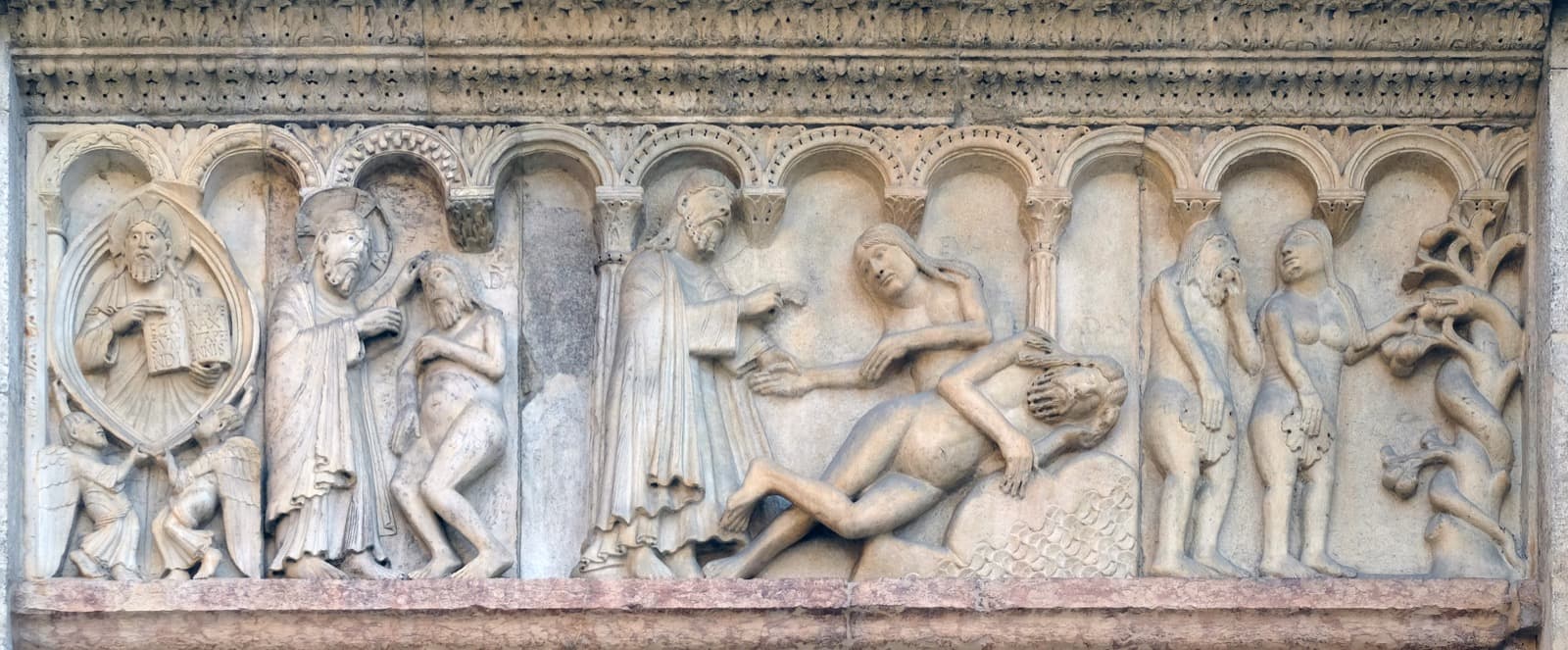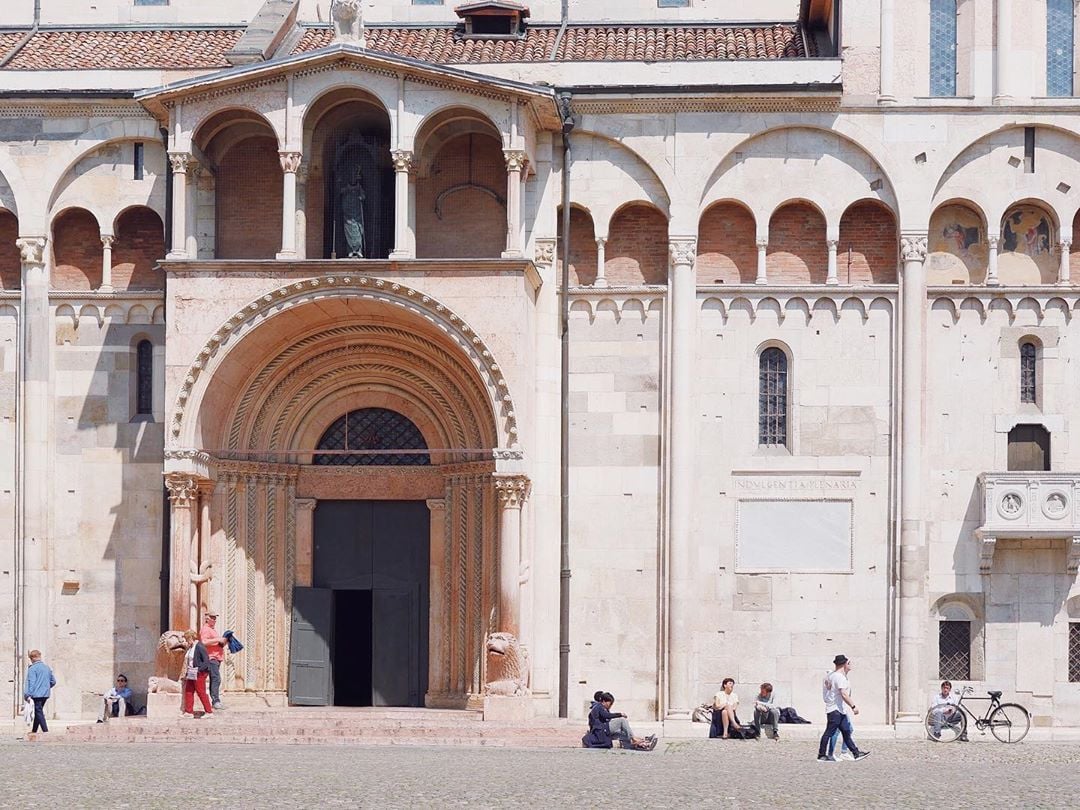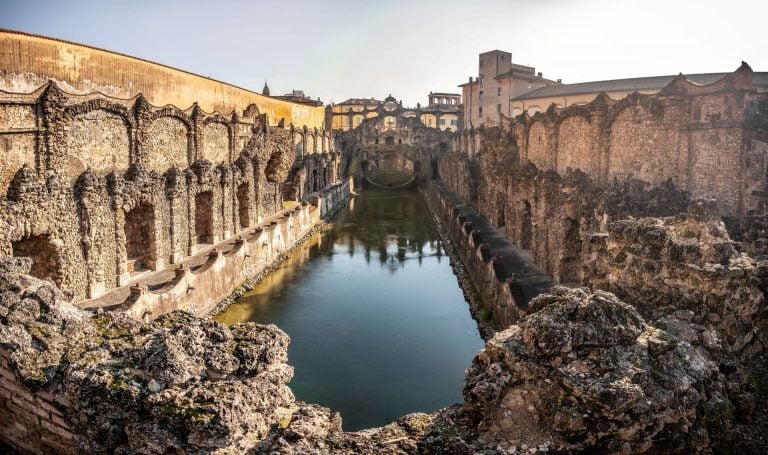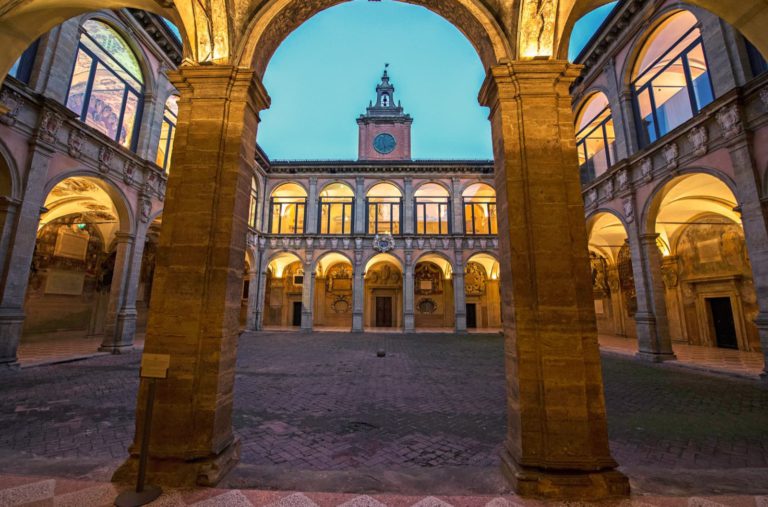Lanfranco and Wiligelmo. Two somewhat unusual names that must have been on everyone’s lips in 11th-century Modena. Without them, today the city would not have its Duomo – the Cathedral of Santa Maria Assunta in Cielo and San Geminiano – one of the Unesco heritage sites in the city centre along with the Ghirlandina tower and the square in which they stand, Piazza Grande.
Whether you have already visited it or not, get ready to cross the threshold of the Modenese cathedral and learn all the secrets of this splendid example of Romanesque art in Emilia Romagna.
The façade

The foundation stone of Modena Cathedral was laid on 9 June 1099, based on a design by architect Lanfranco. Several centuries and some renovations later, the building still impresses us with the purity of its lines and its magnificent exterior decorations.
The most striking example is the white stone façade, made from reclaimed materials from Roman times. Tripartite, salient (i.e. with sloping roofs placed at different heights), it immediately strikes us for its large rose window – the work of the so-called Maestri Campionesi, the architects who took over from Lanfranco in the 12th century – for the series of blind loggias, and of course for the main portal, full of examples of Wiligelmo’s work.
The sculptor, probably a fellow artist and fellow citizen of the Lombard Lanfranco, created numerous bas-reliefs for the cathedral, including the Biblical Stories in the Main Portal. As we approach the entrance, we can admire the vivid scenes depicting Adam and Eve, Noah’s Ark and the stories of Cain and Abel. A kind of comic strip ante litteram, with panels placed side by side to illustrate the Bible to the illiterate.

However, this is not the only example of Wiligelmo’s work on the façade of the cathedral, as he and his workshop indulged in the creation of other bas-reliefs with both sacred and profane themes: from sculptures of prophets to depictions of lions, panthers and other ferocious beasts.
Let us now turn our gaze away from the central portal to observe the openings along the side facades of the building. On the longest side, facing Piazza Grande, we can find the Porta Regia built by the Maestri Campionesi at the beginning of the 13th century, an architectural marvel carved in pink marble. On the same side, the Porta dei Principi (Princes’ Gate) is decorated with the stories of the city’s patron saint, San Geminiano.
Finally, do not miss the Porta della Pescheria (Fish Market Gate), located on the northern façade – that of the Ghirlandina Tower – and its profane sculptures depicting the cycle of the twelve months of the year, chivalrous subjects and scenes inspired by the fables of Phaedrus and Aesop.
The interior of the Duomo

Upon entering Modena Cathedral, we find ourselves surrounded by a three-nave environment, characterised by a raised presbytery hiding a crypt. As with the façade, the interior of the cathedral is also the result of the work of various architects. First of all Lanfranco, followed by the so-called ‘Maestri Padani’ (authors of the ambo and the ramp leading to the crypt) and then the aforementioned Campionesi, who worked on the decorations and the bell tower.
After exploring the apse area, it is time to head for Lanfranco’s crypt. Not only does it house the mortal remains of San Geminiano, but also a truly original group of sculptures. This is the Porrini Group, also known as the Madonna della Pappa, a series of life-size terracotta figures painted by Guido Mazzoni around 1480 depicting the Madonna and Child, two saints and a servant girl. The latter is immortalised in the funny act of blowing on a bowl to cool the food before handing it to Baby Jesus, hence the name of the work itself (”pappa” meaning baby food in Italian).
3 fun facts about Modena Cathedral

Like most cathedrals, the Duomo di Modena has its mysteries too. The first one takes us back to the time when the Po Valley was nothing more than a sea, inhabited by fish and other marine species. What does this actually have to do with the cathedral of Modena? Just look above the Porta Regia to find out: a large whale bone will appear before your eyes, mistaken for a dragon bone in the Middle Ages and placed here to drive out the devil.
If we look closely, we can discover further evidence of the area’s ‘maritime’ past. Set into the pink marble of the Porta Regia, particularly in its steps, you will find ammonites, large molluscs with spiral-shaped shells that disappeared a good 65 million years ago.
Let’s now move to the opposite side of the building and stand in front of the Fish Market Gate to look for the third fun fact. Here, among the bas-reliefs that adorn the portal we can see some scenes depicting the adventures of King Arthur, sculpted at the beginning of the 12th century. The story of the legendary British king, however, was not told by Godfrey of Monmouth in the Historia Regum Britanniae until twenty years later, in 1136. How then does one explain this time discrepancy with the bas-reliefs in the cathedral? According to the most widely accepted hypothesis, it was the pilgrims from northern Europe who passed on Arthur’s story by word of mouth on their way to Rome. And this is how it reached Modena.
Author

Maria Grazia Masotti
An eternal dreamer, but I try to stay grounded. I was raised in the countryside but I love big cities. I’m always ready for a trip, as long as it’s sustainable.
You may also like
Este palaces and residences between Modena and Reggio Emilia
by Maria Grazia Masotti /// July 13, 2023
Emilia-Romagna for kids: Modena and surroundings
by Elisa Mazzini /// May 9, 2023

Interested in our newsletter?
Every first of the month, an email (in Italian) with selected contents and upcoming events.


